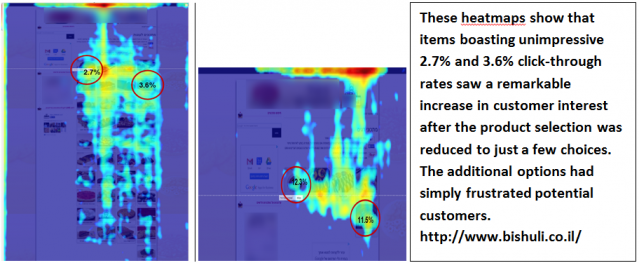Decision-Making
The Psychology of Choice
Choices can become overwhelming, so make it easier for customers.
Posted October 3, 2014
Imagine the following scenario: All your friends have long been involved in relationships, and you are tired of being the third wheel at every social gathering. After a few failed matchmaking attempts, you decide to try a dating website. Soon you discover a new and exciting world that had previously been unknown to you. Suddenly you have many suitors and your dating possibilities become endless! This experience makes you feel truly attractive and desired and, without even noticing, you become addicted. But make no mistake, you are not addicted to love or dating; you are addicted to the idea of having many possibilities available to you.
The above scenario exemplifies a basic human trait: people love to have many options, even if they only exist in theory. When asked, who wouldn’t prefer to choose from a list of five different items over a list of only two? Intuitively, people feel that the more options they have, the greater their chances are of finding the choice that will perfectly satisfy their needs. But this intuitive assumption turns out to be an illusion – the more options we have, the less likely we are to make a decision at all.
To Buy… or Not to Buy
The availability of seemingly unlimited possibilities is of course not exclusive to dating sites. We live in a world of abundance, where we can find and purchase virtually anything that we want. But this wealth of choices can become an overwhelming experience.
Observations of visitor behavior on multiple eCommerce websites has shown that, when customers are given a large number of options to choose from, they have a much harder time making a decision than those who use the sites' filtering tools to limit the number of possible choices. Visitors that try to scan through all of the different products available inevitably become frustrated and leave the website altogether. This is because having too many options causes a sort of paralysis in the decision-making process, which leads to avoidance behavior – i.e. choosing to do nothing at all. In the instances when a choice is made under these conditions, it is usually accompanied by frustration.
Professor Sheena Iyengar discusses this phenomenon in her book “The Art of Choosing.” A grocery store presented customers with two different sampling stations: one with 24 flavors of jam and the other with only six options. The results of the study revealed that the availability of six options resulted in 30% of consumers purchasing at least one jar of jam, while the sampling station with 24 flavors had a conversion rate of only 3%. While the larger selection attracted more onlookers, the smaller selection actually generated more sales.
Why does this happen?
When we are presented with many options, we usually fear making the wrong decision. This can be translated into simple math – when there are only two options, we have a 50% chance of choosing the right one. But when there are five options, our chances suddenly decrease to 20%. Matters become even more complicated when there are twenty options or more. Human cognitive ability cannot efficiently compare more than five options, so most of us will start looking at the first few options and then stop.
Awareness that there may be a better option triggers the urge to find it. However, due to time constraints and human cognitive limitations, we are unable to engage in the elaborate thought process required to compare and contrast all of the available alternatives.
The ‘ever-changing reference point’ is another factor that plays a role in the selection process. Whenever a new alternative is made available, the reference point is changed, thus creating a new perspective for the customer. Imagine you are looking to buy an iPad on eBay. Before viewing the different items on this category, you limited your search results to include only devises that cost $100 – $150. After viewing the first four devises which met your basic expectation, you suddenly see the same devise as the first four but with expended memory. Suddenly, your standard level changes. “Oh,” you think, “I can get an iPad with expanded memory for this budget, why should I settle for less?” Your comparison criteria have changed. From that point on, you will compare all other devises to the one with the expended memory. Your reference point changed, effectively making your choice a one-way street. Once you take it, you cannot go back to your original reference point and settle for less.
Visitor behavior on a recipe website tells the same story; the presence of too many options interferes with our ability to make a decision. When selecting a recipe from the “Cakes” product page, visitors were observed to have a very difficult time reaching a decision -- until the options were artificially limited, at which point the percentage of clicks increased significantly. It’s worth noting that the observed mouse move level was high for both versions of the page, meaning that the items were considered carefully, but the large selection harmed the decision making process. This behavior demonstrates that even when fulfilling one of our most basic and primal needs, an excess of options can prevent our cognitive systems from processing the information efficiently. The system becomes overwhelmed and the decision-making process is disrupted.


The heatmap was taken from Bishuli - Cooking Blog
How can businesses benefit?
Businesses must intelligently limit the number of options that are presented to customers. This doesn’t mean dramatically cutting the number of options available, but rather presenting them wisely, as an in-store sales representative would do when assisting a customer. There are several efficient methods for easing the selection process and giving the customer the direction he needs.
One good way to avoid cognitive overload is to ensure that no row contains more than five items, and to format the page such that each product is enlarged when the customer places his mouse over it. This will separate the items in each row from the rest of the items on the page, as well as making each product stand out as a separate unit. Our brains then register the decision making process as a manageable task, and assign the required cognitive resources.
Another efficient method is filtering, which allows the customer to drill down to the most relevant options. This is similar to an in-store customer service representative telling you, “Let me know what color and size you need, and I will bring it to you.” Companies can also structure the choice to make it easier for visitors to search for a good alternative; for example, they might arrange the information on a store page to align options by brand, purpose or mood (romantic, sexy or fun).
Providing a ‘default’ or ‘suggested’ option is another proven method of helping customers stay focused. It tells the customer, “This item fulfills all of your basic needs and it is sold for a reasonable price. Most of our customers choose this one.”
Social comparison can also be used as a facilitator, as in “Most visitors who share your profile choose this option” or “Customers who viewed this item also looked at these other options.” These sentences are socially oriented, helping the customer to feel like part of a group and thus fulfilling our basic need of wanting to ‘belong.’ This relates to another strategy often used by brick-and-mortar sales reps: using statements like “Business women usually pick this bag” so potential customers will unconsciously associate a product with a group they would like to be a part of.
Most people welcome help when making a purchasing decision, as long as it is not pushy. Digital media is the perfect platform to address these needs, because it allows businesses to provide their customers with appropriate guidance and direction while taking into account their cognitive limitations.




